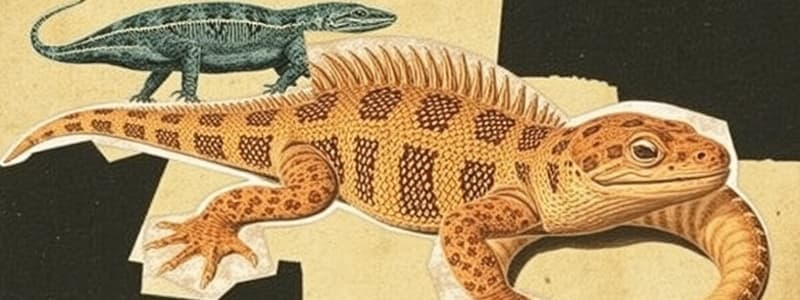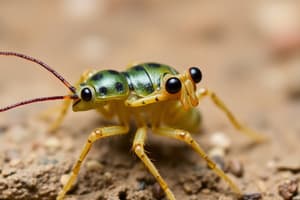Podcast
Questions and Answers
Which characteristic distinguishes vertebrates from invertebrates?
Which characteristic distinguishes vertebrates from invertebrates?
- Protective skin.
- Presence of muscles.
- Absence of a nervous system.
- Internal skeleton. (correct)
Which habitat is least likely to be inhabited by reptiles?
Which habitat is least likely to be inhabited by reptiles?
- Polar ice cap (correct)
- Desert
- Wetland
- Forest
What adaptation primarily enables fish to live in water?
What adaptation primarily enables fish to live in water?
- Cold-bloodedness
- Scales on their skin
- Gills for breathing (correct)
- Laying eggs
Which of the following is a key characteristic of amphibians that allows them to thrive in both terrestrial and aquatic environments?
Which of the following is a key characteristic of amphibians that allows them to thrive in both terrestrial and aquatic environments?
What structural adaptation do birds have that directly aids in their ability to fly?
What structural adaptation do birds have that directly aids in their ability to fly?
Which unique trait classifies whales as mammals despite living in water and lacking fur?
Which unique trait classifies whales as mammals despite living in water and lacking fur?
What is the primary function of the backbone in vertebrates?
What is the primary function of the backbone in vertebrates?
How do reptiles primarily regulate their body temperature?
How do reptiles primarily regulate their body temperature?
Which of the following characteristics is shared by both fish and reptiles?
Which of the following characteristics is shared by both fish and reptiles?
How does the skin of amphibians differ from that of reptiles?
How does the skin of amphibians differ from that of reptiles?
Which of these is an adaptation that allows amphibians to thrive in both land and water environments?
Which of these is an adaptation that allows amphibians to thrive in both land and water environments?
What characteristic is exclusive to mammals?
What characteristic is exclusive to mammals?
If an animal is warm-blooded, has feathers and wings, and lays eggs, how would it be classified?
If an animal is warm-blooded, has feathers and wings, and lays eggs, how would it be classified?
If an animal is found to have an internal skeleton, muscles, and blood circulating through vessels, to which group does it likely belong?
If an animal is found to have an internal skeleton, muscles, and blood circulating through vessels, to which group does it likely belong?
How does living on land affect the reproductive strategy of reptiles compared to fish?
How does living on land affect the reproductive strategy of reptiles compared to fish?
What is one of the primary challenges faced by amphibians due to their scaleless skin?
What is one of the primary challenges faced by amphibians due to their scaleless skin?
A wildlife biologist discovers a new species of animal. The animal has dry skin with scales, lays eggs on land, and is cold-blooded. How would this animal be classified?
A wildlife biologist discovers a new species of animal. The animal has dry skin with scales, lays eggs on land, and is cold-blooded. How would this animal be classified?
How does the habitat of birds influence their physical adaptations, particularly in terms of bone structure?
How does the habitat of birds influence their physical adaptations, particularly in terms of bone structure?
If a mammal is observed living primarily in aquatic environments and giving birth to live young, which additional characteristic would confirm its classification as a mammal rather than a fish?
If a mammal is observed living primarily in aquatic environments and giving birth to live young, which additional characteristic would confirm its classification as a mammal rather than a fish?
Why is it important for amphibians to live near bodies of water?
Why is it important for amphibians to live near bodies of water?
Flashcards
Vertebrates vs. Invertebrates
Vertebrates vs. Invertebrates
Possession of an internal skeleton
Unlikely Reptile Habitat
Unlikely Reptile Habitat
Polar ice caps due to freezing temperatures.
Fish Adaptation for Water
Fish Adaptation for Water
Gills extract oxygen from the water.
Amphibian Key Characteristic
Amphibian Key Characteristic
Signup and view all the flashcards
Bird Adaptation for Flight
Bird Adaptation for Flight
Signup and view all the flashcards
Whale Classification as Mammals
Whale Classification as Mammals
Signup and view all the flashcards
Primary Function of Backbone
Primary Function of Backbone
Signup and view all the flashcards
Reptile Body Temperature Regulation
Reptile Body Temperature Regulation
Signup and view all the flashcards
Shared Fish and Reptile Characteristic
Shared Fish and Reptile Characteristic
Signup and view all the flashcards
Amphibian vs. Reptile Skin
Amphibian vs. Reptile Skin
Signup and view all the flashcards
Adaptation for Amphibians
Adaptation for Amphibians
Signup and view all the flashcards
Exclusive Mammal Characteristic
Exclusive Mammal Characteristic
Signup and view all the flashcards
Warm-blooded, feathers, wings, lays eggs
Warm-blooded, feathers, wings, lays eggs
Signup and view all the flashcards
Animal with internal skeleton, muscles, blood vessels
Animal with internal skeleton, muscles, blood vessels
Signup and view all the flashcards
Reproduction: Reptiles vs. Fish
Reproduction: Reptiles vs. Fish
Signup and view all the flashcards
Challenge for Amphibians
Challenge for Amphibians
Signup and view all the flashcards
Animal with dry, scaly skin, laying eggs on land
Animal with dry, scaly skin, laying eggs on land
Signup and view all the flashcards
Birds Bone Structure
Birds Bone Structure
Signup and view all the flashcards
Confirm Mammal Classification
Confirm Mammal Classification
Signup and view all the flashcards
Amphibians need water
Amphibians need water
Signup and view all the flashcards




